Legislative Analyst's Office
February 22, 1995
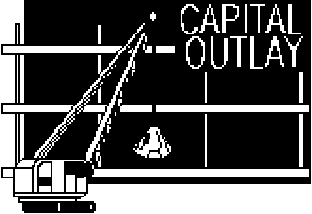
Capital Outlay Overview
Major Issues
- Comprehensive Statewide Capital Outlay Plan Needed. The state is faced with multi-billion dollar capital outlay needs, a relatively high debt burden, and dwindling resources to fund capital outlays. We recommend that the Legislature take a more comprehensive and proactive approach to this issue by developing a multi-year financing strategy based on a statewide needs assessment and an evaluation of its funding priorities. (See page I-13.)
- Policy Guidance Needed on Acquiring State Office Buildings. The administration is proposing $560 million for five new state office buildings. These proposals are not in the budget but will be proposed in separate legislation. We recommend that the Legislature instead consider these proposals during the budget process in the context of the Legislature's statewide capital outlay priorities and other state program expenditures. The Department of General Services should also provide specific information to justify the need and benefit of individual projects. (See page I-20.)
- Expanded Use of Lease-Payment Bonds Proposed. For several departments, the budget proposes to use lease-payment bonds to finance all project costs, including preconstruction costs such as land acquisition and design. The amount of funding proposed for these projects is not needed in the budget year and using such financing for preconstruction activities is costly. We recommend that the Legislature instead use General Fund monies for these activities for specific projects proposed for the Office of Emergency Services and the Department of Forestry and Fire Protection. (See pages I-24, I-27, and I- 39.)
- State Building Seismic Safety Program. The budget proposes $165 million from earthquake safety bonds for structural retrofit of several state buildings. We recommend that the Legislature (1) earmark these bond funds to protect the maximum number of building occupants in the event of an earthquake, (2) use these limited funds to address buildings determined to have the highest seismic safety risk, (3) require better-defined retrofit solutions and cost estimates before approving construction funding and (4) provide only those project funds that can be encumbered in the budget year. (See page I-30.)
- State Prisons--Emergency Housing Proposal. The budget proposes $168 million to add over 20,000 beds to existing prisons as emergency housing for male inmates. We withhold recommendation pending receipt of information on the specific elements of the proposal and the department's updated inmate population projections that will be available in the spring. The need for these beds could also be affected by any policy changes the Legislature may wish to adopt to reduce prison costs. (See page I-45.)
Overview
Capital outlay expenditures account for a slightly increased share of total state spending as a result of increased debt service payments for bonds that have been used to acquire capital assets.
Expenditures for capital outlay are proposed to total $2.5 billion from all state funds in 1995--96. This is about $180 million, or 7.7 percent, more than estimated current-year expenditures. Capital outlay expenditures reflect the state's current costs for capital outlay programs, either through debt service payments or direct appropriations (pay-as-you-go financing) to acquire assets. (The expenditure figure does not include the proposed appropriations of bond proceeds, because they do not represent a cost to the state until the bonds are paid off in future years.)
The $2.5 billion in 1995-96 expenditures has three components:
- Debt service payments for general obligation (GO) bonds ($2 billion).
- Payments for debt service on lease-payment bonds ($388 million).
- Direct appropriations from the General Fund and from various special funds ($121 million).
As shown in Figure 1, expenditures for capital outlay, excluding the state water project and direct expenditures on transportation, have increased significantly since 1988-89 growing from less than $700 million to $2.5 billion in 1995-96. This increase is directly attributable to the increase in debt service payments on GO bonds and lease-payment bonds. Over this same period, debt service payments have increased from $550 million to $2.4 billion, or 340 percent. Figure 1 shows that General Fund expenditures for capital outlay (most of which is debt service) have increased from less than 2 percent of General Fund spending in 1988 to almost 6 percent in the budget year.
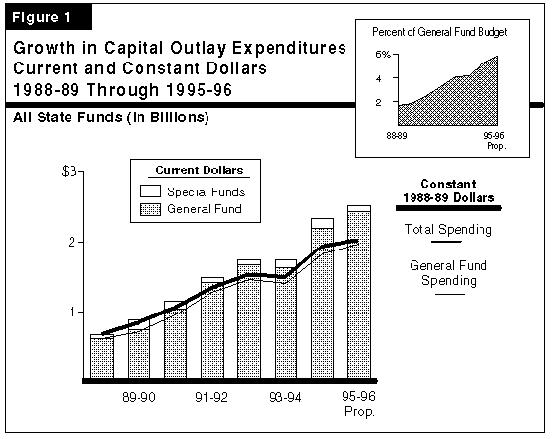
The proposed budget-year changes, by component of capital outlay expenditure, are as follows:
- General Obligation Bond Debt Service. The Governor's Budget reflects an estimated $112 million (5.9 percent) General Fund cost increase over current-year expenditures of about $1.9 billion for general obligation bond debt service.
- Lease-Payment Bond Debt Service. Debt service payments for lease-payment bonds (also called lease-revenue bonds or Public Works Board bonds) are estimated to total $388 million in 1995-96. This is an increase of $75 million, or 23 percent, over the current year. These bonds are primarily used for higher education facilities, prisons, and state office buildings. About 93 percent of the debt service on these bonds comes from the General Fund.
- Direct Appropriations. Capital costs through proposed direct appropriations total $121 million the same as for 1994-95. These expenditures include $74 million from the General Fund and $47 million from various special funds, such as the Motor Vehicle Account.
Debt Service Ratio
The amount of debt service as a percentage of state General Fund revenues (that is, the state's debt ratio) is estimated to be 5.2 percent for the current year. The ratio has risen sharply in recent years, as it was only 2.5 percent in 1990-91. (A significant reason for this increased debt burden has been the lack of growth in General Fund revenues.) As shown in Figure 2, if all previously authorized bonds are sold (and no others are authorized), the state's debt ratio would reach a peak of about 5.4 percent in 1995-96 and then decline thereafter. (This estimate does not assume enactment of the Governor's tax cut and state-local restructuring proposals.) The figure also shows the impact of the Governor's proposed 1995-96 lease-payment bond authorizations. These additional bonds will not increase the peak of 5.4 percent but will raise the debt ratio in future years by about 0.5 percent.
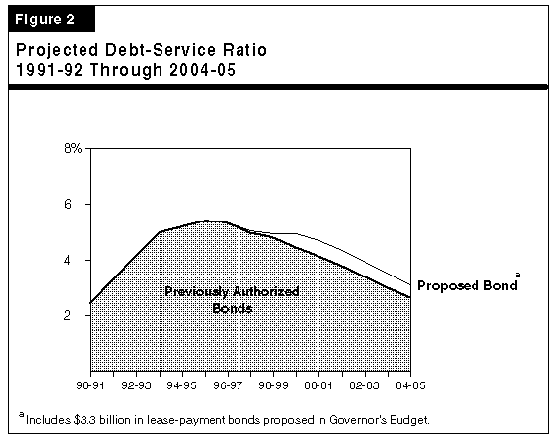
Spending by Major Programs
About $2.1 billion, or 83 percent, of capital outlay expenditures fall within four areas K-12 education, youth and adult corrections, resources, and higher education. Figure 3 shows the expenditures in each of these areas over the past three years. The figure reflects the increased costs to make debt payments on bonds issued for these programs. The expenditures do not necessarily reflect actual construction activity because of the lag between construction, bond sales, and debt payments.
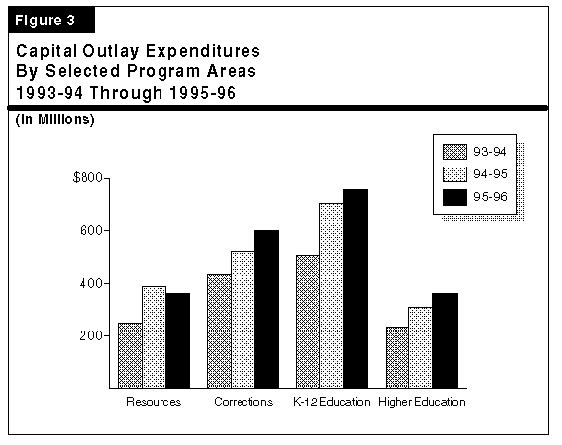
As shown in Figure 3, expenditures are increasing most rapidly for K-12 education (50 percent over three years) and higher education (54 percent over three years). No new bonds were authorized for K-12 facilities in 1994 and most of the previously authorized bonds have been allocated to specific K-12 projects and sold. Debt service costs in this area will increase little after 1995-96 unless additional K-12 bonds are authorized by the voters.
Debt service for corrections capital outlay has not increased as much as that for education. However, this is in part because the major capital outlays in this area are for new prisons, which have recently been funded with lease-payment bonds. Because the state does not incur debt service on these bonds until after the prisons are completed, there is a significant lag between the bond sales and when the debt service payments begin. The state will thus incur higher debt service costs in the next few years as previously authorized new prisons are completed. In addition, as discussed in the next section, the Governor is proposing an additional $2.3 billion in lease-payment bonds for youth and adult corrections capital outlay.
Summary of the 1995-96
Capital Outlay Program
We now turn from a discussion of capital outlay expenditures (the current costs of paying for capital assets) to a summary of the 1995-96 capital outlay program (proposals to obtain capital assets). The budget includes $877 million for capital outlay programs (excluding transportation systems). This is an increase of $600 million, or 224 percent, over current-year funded appropriations. The reason that this increase is so substantial is that $513 million in capital outlay appropriations in the 1994 Budget Act were from proposed general obligation bonds that were either not approved by or not placed before the voters.
Figure 4 compares each department's capital outlay funding request for 1995-96 with the amount approved by the Administration for inclusion in the Governor's Budget. The budget includes almost 80 percent of the $1.1 billion requested. As shown in the figure, the projects in the budget have a future completion cost of $174 million. Almost 50 percent of this future cost is for the University of California.
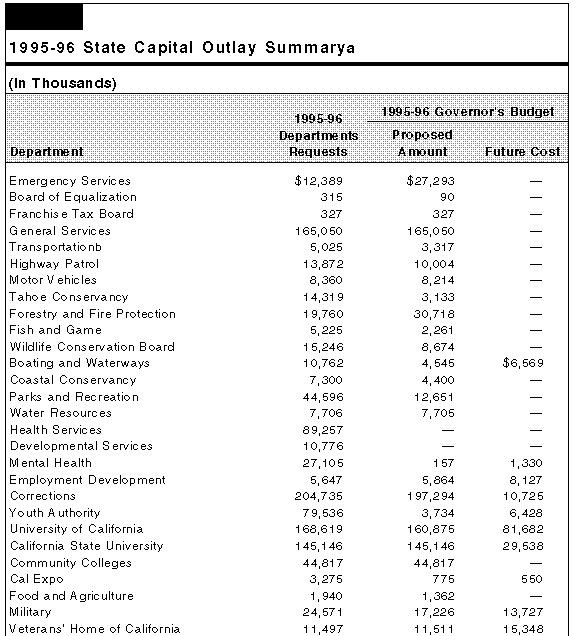

Figure 5 shows the budget proposal for each department by funding type. Over 80 percent of all funding is proposed from bonds $205 million in general obligation bonds (primarily for state office building seismic projects) and $525 million in lease- payment bonds. The budget also includes $74 million from the General Fund for capital outlay projects. Other capital outlay funding is proposed from various special funds ($54 million) and from federal funds ($18 million).
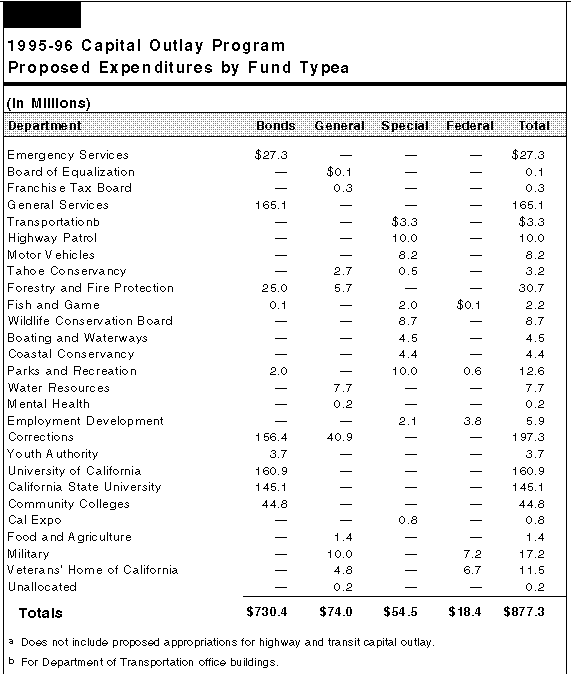
Governor's Bond Proposals
In addition to the bond proposals outlined above, the Governor indicates his support for additional lease-payment bonds of over $2.7 billion. These bonds, which would be authorized through separate legislation, would finance the following:
- $2 billion for six new prisons that would add 13,800 beds to the state's prison system.
- $181.4 million to add 1,950 beds for the California Youth Authority.
- $560 million for five new state office consolidation projects.
School Facilities Program. Almost all general obligation bonds previously approved for K-12 school facilities have been allocated and, without a special election, no additional bonds could be approved by the voters before March 1996. The Governor is therefore proposing a new way to fund school facilities both as an interim option for districts until new bonds are available and as an alternative to the existing state lease-purchase program if and when new bonds are authorized. Under this program, the state would make loans to districts by selling revenue bonds. The loans would be paid off through deductions to districts' apportionments. In other words, schools would pay for the facilities over time from within their existing resources. Proposition 98 funds would be provided to districts meeting certain hardship criteria (as yet defined) to assist in repaying their loans. It is our under standing that it is not the administration's intent to increase the total Proposition 98 allocation to provide this funding assistance.
Return to Analysis and Perspectives and Issues Page






